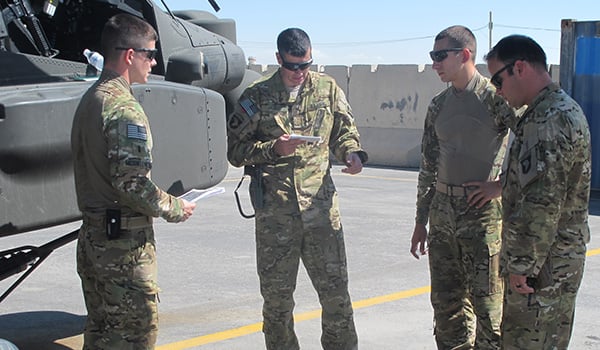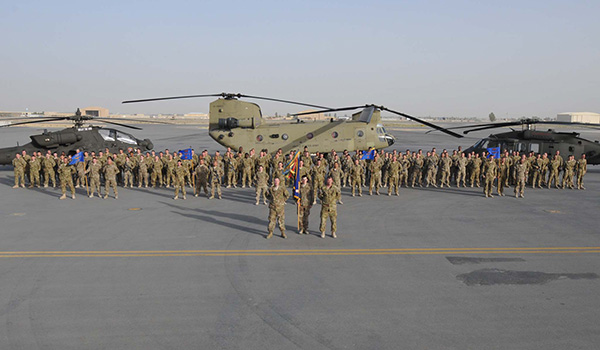
AH-64E Manned-Unmanned Teaming / By CW4 Brett S. Chivers: Technological advancements in combat systems, especially in Army aviation, have seen marked improvements over the past 14 years of war. One of the most notable of these advancements is the development and integration of unmanned aircraft systems (UAS) by all four branches of the military. Army Aviation is committed to not only integrating UAS into the fight, but also into its newly configured combat aviation brigades (CAB). The Aviation Restructuring Initiative (ARI), which is currently ongoing, has removed the OH-58 Cavalry squadron from the CAB and replaced it with a second AH-64 attack/reconnaissance battalion. In order to retain the Cavalry mission, the second AH-64 battalion is equipped with three RQ-7B Shadow platoons. With both UAS and AH-64s being organized in the same unit, there is a purposeful focus on full integration of those assets as offensive tactical systems.

MAJ Tyler Cody, 1-101st Avn. executive officer, briefs crews for a manned-unmanned teaming (MUM-T) mission in Afghanistan, May 11, 2015./ 1-101ST AVN COURTESY PHOTO
Army Aviation’s initiative towards a restructured CAB is leading the way towards a more effective and advanced fighting unit. Along with organizational restructuring come doctrine, training and material considerations. Not only is the attack helicopter community learning how to integrate a new system into its formation, the UAS community is also transitioning from Military Intelligence to Army Aviation. The shift in organizational structure and parent branch lends to challenges in the synchronization of fielding new equipment and often complicates the merger and training of these units.
Developing Capability
In early 2009, 1st Bn., 10th Avn. Regt., 10th CAB was fielded with the first generation of hardware and software that brought live UAS full motion video (FMV) into the AH-64 cockpit. The system was called Video from Unmanned Aerial Systems for Interoperability Teaming – Level 2 (VUIT-2). VUIT-2 was designed to receive C, L and UHF band video feeds from multiple unmanned platforms. VUIT-2 was equipped with a Mini-Tactical Common Data Link (MTCDL) system that permitted the transmission of received UAS or aircraft sensor video to a ground or airborne One System-Remote Video Terminal (OSRVT). Although it had functionality and was capable of MUM-T like operations, the system was not easy to operate and needed improvements. 1-10th had issues getting other services to understand their FMV capability, which brought limited success in working with them during operations.
In 2012, 1st Bn., 101st Avn. Regt. became the first operational unit fielded with the next generation of system for UAS integration, known as the Manned Unmanned Teaming (MUM-T) system. MUM-T was an upgrade from the VUIT-2 system. The unit’s initial fielding included nine upper re-ceivers (UR), able to receive C, S, L, & Ku band video feeds. Additionally, all 24 AH-64Ds were also fielded with the Air to Air to Ground (AAG) system. The AAG, equipped with a Ku band receiver and transmitter, was designed to receive and transmit organic Target Acquisition Designation Sight (TADS) video as well as retransmit TADS and UAS video. AAG is also compatible with the ground force’s OSRVT.
The MUM-T system recently received a significant upgrade in capability for use on the next latest generation AH-64E, adding two more levels (3 and 4) of UAS interoperability. There are a total of four levels of interoperability (LOI) that can be achieved when operating with UAS; they include:
- Level 1 Receipt and transmission of secondary imagery or data.
- Level 2 Receipt of imagery or data directly from the UAS.
- Level 3 Control of the UAS payload.
- Level 4 Control of the UAS, less takeoff and landing.
Limitations
The increased capability to control a UAS sensor (LOI 3) and flight path (LOI 4) directly from the Apache increases situational awareness, operational reach, and survivability. LOIs 3 and 4 were achieved through the use of the Unmanned Aerial Vehicle Tactical Common Data Link Assembly (UTA), which is a Ku band directional antenna with two way control capability. The UTA operates on the Army’s new standard of technology known as Tactical Common Data Link (TCDL). TCDL is currently limited to the AH-64E Apache and the MQ-1C Gray Eagle.

1st Battalion, 101st Aviation Regiment, 101st Combat Aviation Brigade, 101st Airborne Division (Air Assault) in Afghanistan, May 17, 2015. / 1-101ST AVN COURTESY PHOTO
The UTA was a huge step forward in UAS integration, but brought with it a significant degradation to the Apache’s MUM-T capability. The UTA is incapable of receiving C, L, & S band FMV feeds. These feeds are common to all legacy Army UAS as well as all Air Force, Navy, and Special Operations ISR platforms. Although the UTA brought increased interoperability with the MQ-1C Gray Eagle, it prevents the AH-64E from receiving feeds from any other UAS on the battlefield.
AH-64E and Deployment
In the spring of 2014, 1-101st began fielding the AH-64E. Unit leaders and senior aviators identified the capability gap between the AH-64D’s UR and the AH-64E’s UTA early in the fielding process and requested, through an Operational Needs Statement (ONS), UR and legacy MUM-T capability on the AH-64E. Apache PM recognized the need for this capability and initiated development of upgraded aircraft software that would allow the use of the UR on the AH-64E. 1-101st Avn. Regt.’s ONS was approved and the unit was scheduled to receive URs in the fall of 2014.

An AH-64E from 1st Battalion, 101st Combat Aviation Brigade, Task Force Expect No Mercy, taxis out for another mission in Afghanistan, April 23, 2015./ 1-101ST AVN COURTESY PHOTO
The 1-101st deployed to Afghanistan in the spring of 2015. Increasing the Apache crew’s proficiency in operating MUM-T became one of the unit’s main efforts. Apache PM was extremely helpful and responsive in assisting the unit with troubleshooting the AAG and UR setup procedure in an effort to make tuning different UAS platforms easier. The unit’s intelligence section assumed the role of intelligence, surveillance, reconnaissance (ISR) manager, compiling contacts and data on all available systems in theater from which the Apaches could possibly receive FMV feeds. Through repetition, the aviators gained familiarity and eventually confidence in the MUM-T system. After six weeks, the unit’s efforts resulted in successfully utilizing the MUM-T/UR in conjunction with an Air Force MQ-9 Reaper to respond to Indirect Fire (IDF). Success was due to the efforts of the staff, aircrews and maintainers.
Although the unit found a few road blocks to making MUM-T an effective tool, it proved that with the right people and effort, MUM-T can increase an Apache battalion’s effectiveness significantly. The road ahead for MUM-T for the U.S. Army and for the Department of Defense is to consolidate the effort for all airframes and systems, so that it is easier for the end user to operate. In addition a consolidated effort in knowledge management of the emerging technologies is necessary to ensure the tactical units currently operating in combat conditions have the information necessary to be more effective.
CW4 Brett S. Chivers is currently serving as the Aviation Mission Survivability Officer for 1st Battalion, 101st Aviation Regiment, 101st Combat Aviation Brigade, 101st Airborne Division (Air Assault). His previous experience includes 4 years flying MH-47G Chinooks for the 160th Special Operation Aviation Regiment (SOAR); he is also AH-64 A/D/E qualified.
MAJ Tyler Cody, 1-101st Avn. executive officer, briefs crews for a manned-unmanned teaming (MUM-T) mission in Afghanistan, May 11, 2015./ 1-101ST AVN COURTESY PHOTO
1st Battalion, 101st Aviation Regiment, 101st Combat Aviation Brigade, 101st Airborne Division (Air Assault) in Afghanistan, May 17, 2015. / 1-101ST AVN COURTESY PHOTO
An AH-64E from 1st Battalion, 101st Combat Aviation Brigade, Task Force Expect No Mercy, taxis out for another mission in Afghanistan, April 23, 2015./ 1-101ST AVN COURTESY PHOTO







